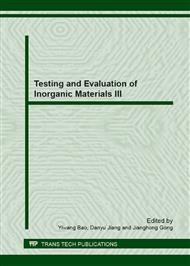[1]
A. Riede, J. Helmstedt, V. Riede, J. Zemek, J. Stejskal, Preparation and characterization of exfoliated polyaniline. Langmuir. 16 (2000) 6240.
DOI: 10.1021/la991414c
Google Scholar
[2]
J.W. Kim, F. Liu, H.J. Choi, S.H. Hong, Intercalated polypyrrole/Na+-montmorillonite nanocomposite via an inverted emulsion pathway method. J. Joo, Polymer. 44 (2003) 289.
DOI: 10.1016/s0032-3861(02)00749-8
Google Scholar
[3]
K.G. Cho, D. Kumar, P.H. Holloway, R. Singh, Luminescence behavior of pulsed laser deposited Eu:Y2O3 thin film phosphors on sapphire substrates. Appl. Phys. Lett. 73 (1998) 3058.
DOI: 10.1063/1.122671
Google Scholar
[4]
Vetrone F, Boyer J C, Capobianco J A. Effect of Yb3+ co-doping on the upconversion emission in nanocrystalline Y2O3: Er3+. J. Phys. Chem. 107 (2003) 1107.
Google Scholar
[5]
R. Bazzi, M.A. Flores-Gonzales, C. Louis, et al., Synthesis and luminescent properties of sub-5-nm lanthanide oxides nanoparticles. J. Lumin. 445 (2003) 102-103.
DOI: 10.1016/s0022-2313(02)00588-4
Google Scholar
[6]
P. Maestro, D. Huguenin, A. Seigneurin, et al., Mixed rare earth oxides as starting material for the preparation of Y2O3:Eu lamp phosphor: characterization and use. J. Electrochem. Soc. 139 (1992) 1479.
DOI: 10.1149/1.2069435
Google Scholar
[7]
K.Y. Jung, C.H. Lee, Y.C. Kang, Effect of surface area and crystallite size on luminescent intensity of Y2O3: Eu phosphor prepared by spray pyrolysis. Mater. Lett. 59 (2005) 2451-2456.
DOI: 10.1016/j.matlet.2005.03.017
Google Scholar
[8]
G.Y. Hong, K. Yoo, S.J. Moon, Enhancement of luminous intensity of spherical Y2O3: Eu phosphors using flux during aerosol pyrolysis. J. Electro chem. Soc. 150 (2003) 67-71.
DOI: 10.1149/1.1556054
Google Scholar
[9]
J. McKittrick, L.E. Shea, C.F. Bacalski, E.J. Bosze, The influence of processing parameters on luminescent oxides produced by combusion synthesis. Dysplays. 19 (1999) 169-172.
DOI: 10.1016/s0141-9382(98)00046-8
Google Scholar
[10]
P. Duran, J. Tartaj, C. Moure, Sintering behaviour of Y2O3 powders prepared by the polymer complex solution method. Ceram. Int. 28 (2002) 791-803.
DOI: 10.1016/s0272-8842(02)00045-7
Google Scholar
[11]
R. Ravi, Growth and characterization of Y2O3:Eu3+ phosphor films by sol-gel process. Solid State Commun. 99 (1996) 439-443.
DOI: 10.1016/0038-1098(96)00249-9
Google Scholar
[12]
Capobianco J A, Boyer J C, Vetrone F, Speghini A, Bettinelli M. Optical spectroscopy and upconversion studies of Ho3+- doped bulk and nanocrystalline Y2O3. Chem. Mater. 14 (2002) 2915.
DOI: 10.1021/cm011584m
Google Scholar
[13]
Y.Q. Zhai, Z.H. Yao, S.W. Ding. Synthesis and charactcriration of Y2O3: Eu nanopowder via EDTA complexing sol-gcl process [J]. Materials Letters. 57 (2003) 2901-2906.
DOI: 10.1016/s0167-577x(02)01394-0
Google Scholar
[14]
M.I. Martinez rubio, T.G. Ireland, J. Silver, Effect of EDTA on controlling nucleation and morphology in the synthesis of ultrafine Y2O3:Eu phosphors. Electrochem. Solid-State Lett. 3 (2000) 446-449.
DOI: 10.1149/1.1391175
Google Scholar
[15]
J.Wan, Z.Wang, X. Chen, L. Mu, Y. Qu, Shape-tailored photoluminescent intensity of red phosphor Y2O3:Eu3+. J. Cryst. Growth. 284 (2005) 538-543.
DOI: 10.1016/j.jcrysgro.2005.07.040
Google Scholar
[16]
M.R. Davolos, S. Feliciano, A.m. Pirez, R.F.C. Marquez, Solvothermal method to obtain europium-doped yttrium oxide. J. Solid State Chem. 171 (2003) 268-272.
DOI: 10.1016/s0022-4596(02)00174-3
Google Scholar
[17]
K. Nakamoto, Infrared spectra of inorganic & coordination compounds. John Wiley & Sons, New York, 1963.
Google Scholar
[18]
J. A. Gadsden, Infrared spectra of minerals and related inorganic compounds. Butterworth, Newton, MA, 1975.
Google Scholar
[19]
J.-G. Li, T. Ikegami, J. H. Lee, and T. Mori, "Well-sinterable Y3Al5O12 powder from carbonate precursor," J. Mater. Res. 15 (2000) 1514-23.
DOI: 10.1557/jmr.2000.0217
Google Scholar
[20]
J.-G. Li, T. Ikegami, J. H. Lee, et al., "Co-precipitation synthesis and sintering of yttrium aluminum garnet (YAG) powders: the effect of precipitant," J. Eur. Ceram. Soc. 20 (2000) 2395-405.
DOI: 10.1016/s0955-2219(00)00116-3
Google Scholar
[21]
Xu, G. G., Zhang, X. D., He, W., Liu, H. and Li, H., The study of surfactant application on synthesis of YAG nano-sized powders. Powder Technol. 163 (2006) 202-205.
DOI: 10.1016/j.powtec.2006.02.004
Google Scholar
[22]
Kaliszewski, M. S. and Heuer, A. H., Alcohol interaction with zirconia powders. J. Am. Ceram. Soc. 73 (1990) 1504-1509.
DOI: 10.1111/j.1151-2916.1990.tb09787.x
Google Scholar


